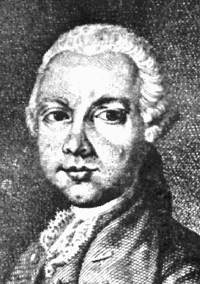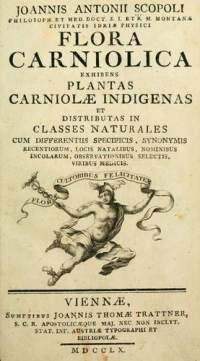Trees Birds Mammals Fish Amphibians Reptiles
Wild Algarve
Bookshop
Giovanni Antonio Scopoli (1723 - 1788) - a brief biography
The information below is derived from many sources; major reference texts are listed at the foot of the page.

In the eighteenth and nineteenth centuries, the names of famous scientists were often written in Latinised form. (For example Carl von Linné became known as Carolus Linnaeus.) You may also see in the literature of that period Giovani Scopoli referred to as Johannes Antonius Scopolius.
Born at Cavalese in the Val di Fiemme, just south of Bolzano in what is now the South Tyrol province of northern Italy, Giovani Scopoli studied medicine at the University of Innsbruck.
In a varied career that gave him experience not only of the Church but also of the mining industry as well as what today we would call 'general practice', Scopoli did not travel widely, although as a physician he worked not only as a doctor in his home town of Cavalese but also, later, in Venice.
Scopoli's first appointment had been as private secretary to the bishop of Seckau, a post he held for just two years before taking on a more 'industrial' role. With a scientific mind that sought tyo find order within Nature, Scopoli was particularly interested in botany and in entomology. He spent much time in the Alps, gathering plants and insects for his extensive collections. Although they never met, Scopoli and Linnaeus corresponded frequently on natural history topics.

Publications
Apart from several medical publications - he became quite an expert on mercury poisoning, having been employed as a physician to mercury-mining communities - Scopoli published Flora Carniolica in 1760 and then three years later Entomologia Carniolica. These works categorised respectively the plant and insect species in his region of the Austrian Empire.
Scopoli also published Anni Historico-Naturales (1769-1772), containing descriptions of birds from various collections.
Scopoli's final work, Deliciae Flora et Fauna Insubricae (1786 to 1788) included scientific names for birds and mammals which the French naturalist and explorer Pierre Sonnerat (1748 - 1814) had described in the accounts of his exploratory travels to the Philippines and Moluccas between 1769 and 1772, and to India and China between 1774 and 1781.
The plant genus Scopolia (within the family Solanaceae, which includes the genus Solanum within which are the tomato and potato) is named in honour of Giovanni Antonio Scopoli. From the creeping plant Scopolia carniolica the drug scopolamine was first extracted. Taken in small doses this alkaloid has anti-spasmodic properties and is used to calm the stomachs of people suffering from motion sickness.
The abbreviation Scop. is used to indicate Giovanni Antonio Scopoli as the author when citing a botanical or mycological name.
Selected Sources:
Soban, Branko. 'A Living Bond between Idrija and Uppsala'. The Slovenian, January 2005.
Fascinated by Fungi, 2nd Edition, Pat O'Reilly 2016, reprinted by Coch-y-bonddu Books in 2022.
Top of page...
Fascinated by Fungi. Back by popular demand, Pat O'Reilly's best-selling 450-page hardback book is available now. The latest second edition was republished with a sparkling new cover design in September 2022 by Coch-y-Bonddu Books. Full details and copies are available from the publisher's online bookshop...